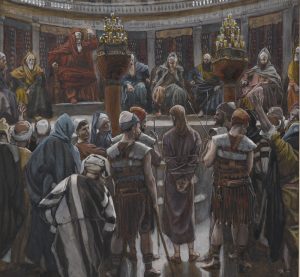
James Tissot (French, 1836-1902). The Morning Judgment, 1886-1894. Brooklyn Museum, Purchased by public subscription, 00.159.254.
As Easter approaches this year, I expect all of the usual debates over the Crucifixion-Resurrection timeline.
Was Jesus crucified on Friday or on Wednesday? Did he rise from the dead Sunday morning, or Saturday night? And, was he literally 3 days and 3 nights in the heart of the earth?
But, there’s another question that needs to be addressed. What exactly did Jesus mean by the phrase “heart of the earth” where he would spend 3 days and nights? Is it a reference to his death and time in the grave? Or does it refer to something broader, something that possibly started sooner?
The answer to this question might be key in answering others, and might change the trajectory of this debate.
The Crucifixion Debate
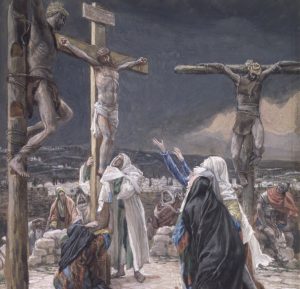
James Tissot (French, 1836-1902). The Death of Jesus, 1886-1894. Brooklyn Museum, Purchased by public subscription, 00.159.305
Matt. 12:40 For as Jonah was three days and three nights in the belly of a huge fish, so the Son of Man will be three days and three nights in the heart of the earth.
The general consensus on both sides is that you can’t have 3 literal days and 3 literal nights, if you hold to the Friday Sunday timeline. If “heart of the earth” is a reference to the grave, there is not enough time between the death of Jesus Friday evening, and his resurrection Sunday morning. Conversely, if we accept the Friday crucifixion, we must understand the 3 days and 3 nights in a more idiomatic sense—3 partial days.
It’s a bit of a conundrum, as there are good arguments on both sides. The Friday crucifixion is overwhelmingly supported by Scripture, and Jesus’ statement about 3 days and 3 nights seems explicit, as well. So which do we choose?
Actually, maybe we don’t have to. Maybe, instead, we can reconcile these two ostensibly opposing truths.
Meaning of Heart of the Earth?
There’s a neglected aspect of this debate that might be preventing us from getting to the true heart of the matter—namely, the meaning of the phrase “heart of the earth.”
I sometimes marvel how seldom this phrase is addressed in the context of this debate. Most are willing to debate the meaning of 3 days and 3 nights (as they should), but rarely do they address the phrase that follows, which actually is a metaphor. You would think it would be up for at least some debate, especially considering it’s only mentioned once in all of Scripture. Hopefully this article will give it the attention it deserves.
First, however, let’s look at the solid biblical case for the Friday crucifixion.
Definitely Friday
Historically, the Church has held that Jesus was crucified Friday morning, died on the cross before sundown, and rose from the dead Sunday morning. Scripture clearly states, in many places, Jesus rose from the dead early the first day of the week (Sunday), which was the third day since his crucifixion. Counting backward, if Sunday is the third day, Saturday is the second day, and Friday the first.
Luke 24 Timeline
This timeline is perhaps best documented in Luke’s 24th chapter. The account begins Sunday morning (the first day of the week) when the empty tomb is discovered.
Luke 24:1 On the first day of the week, very early in the morning, the women took the spices they had prepared and went to the tomb. 2 They found the stone rolled away from the tomb, 3 but when they entered, they did not find the body of the Lord Jesus. (emphasis mine)
The women were met, instead, by Angels who reminded them Jesus rose, just as he said, on the third day.
Luke 24:5 …“Why do you look for the living among the dead? 6 He is not here; he has risen! Remember how he told you, while he was still with you in Galilee: 7 ‘The Son of Man must be delivered over to the hands of sinners, be crucified and on the third day be raised again.’ ” (emphasis mine)
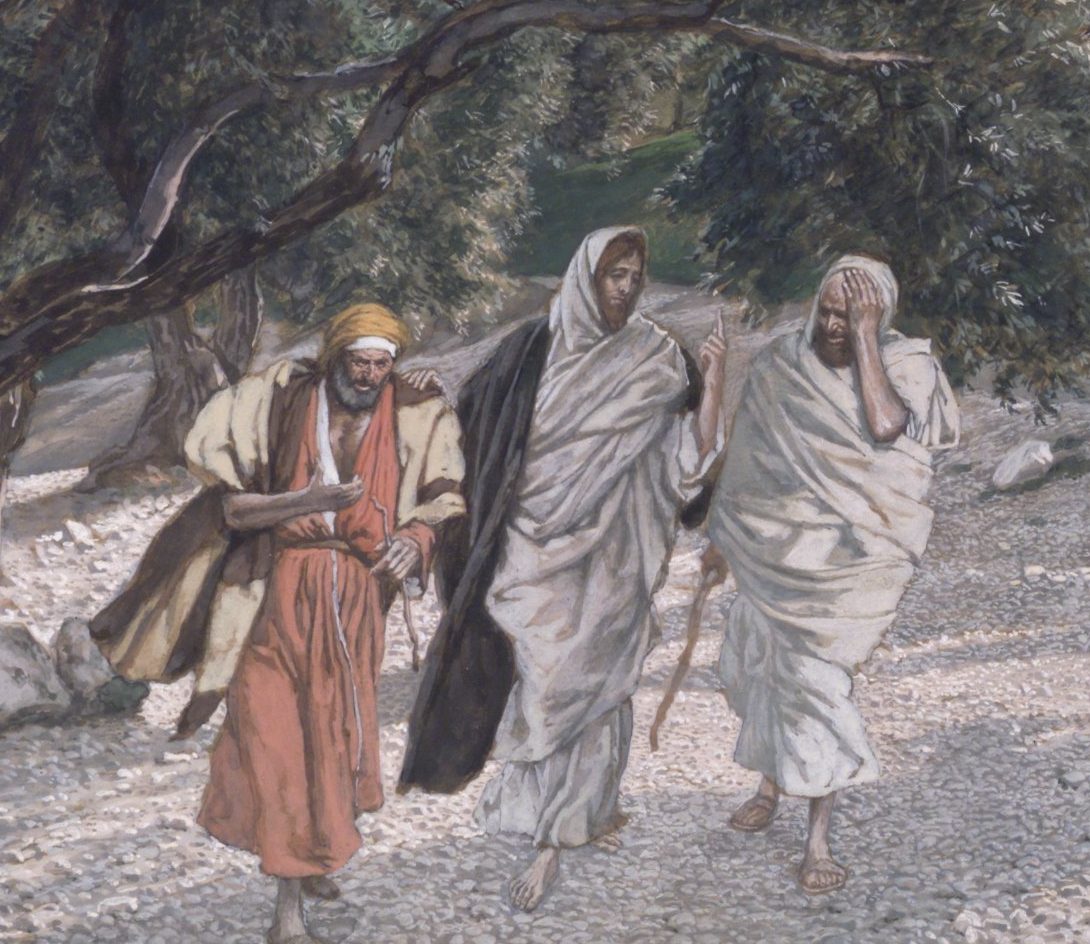
James Tissot (French, 1836-1902). The Pilgrims of Emmaus on the Road, 1886-1894. Brooklyn Museum, Purchased by public subscription, 00.159.338
Luke adds more details through Cleopas who spoke to Jesus (unaware) on Sunday (the first day of the week) on his journey to Emmaus. The passage below confirms that Sunday was the third day.
Luke 24:20 The chief priests and our rulers handed him over to be sentenced to death, and they crucified him; 21 but we had hoped that he was the one who was going to redeem Israel. And what is more, it is the third day since all this took place. 22 In addition, some of our women amazed us. They went to the tomb early this morning 23 but didn’t find his body… (emphasis mine)
We glean three important facts from this: 1) The disciples were speaking with the risen Lord on the first day (Sunday) 2) It was the same day the empty tomb was discovered. 3) It was the third day since Christ’s crucifixion.
Later, in this same chapter, Luke documents Christ himself speaking to the disciples in Jerusalem, affirming he rose the third day.
Luke 24:46 …“This is what is written: The Messiah will suffer and rise from the dead on the third day… (emphasis mine)
The matter is all but settled.
Preparation Day
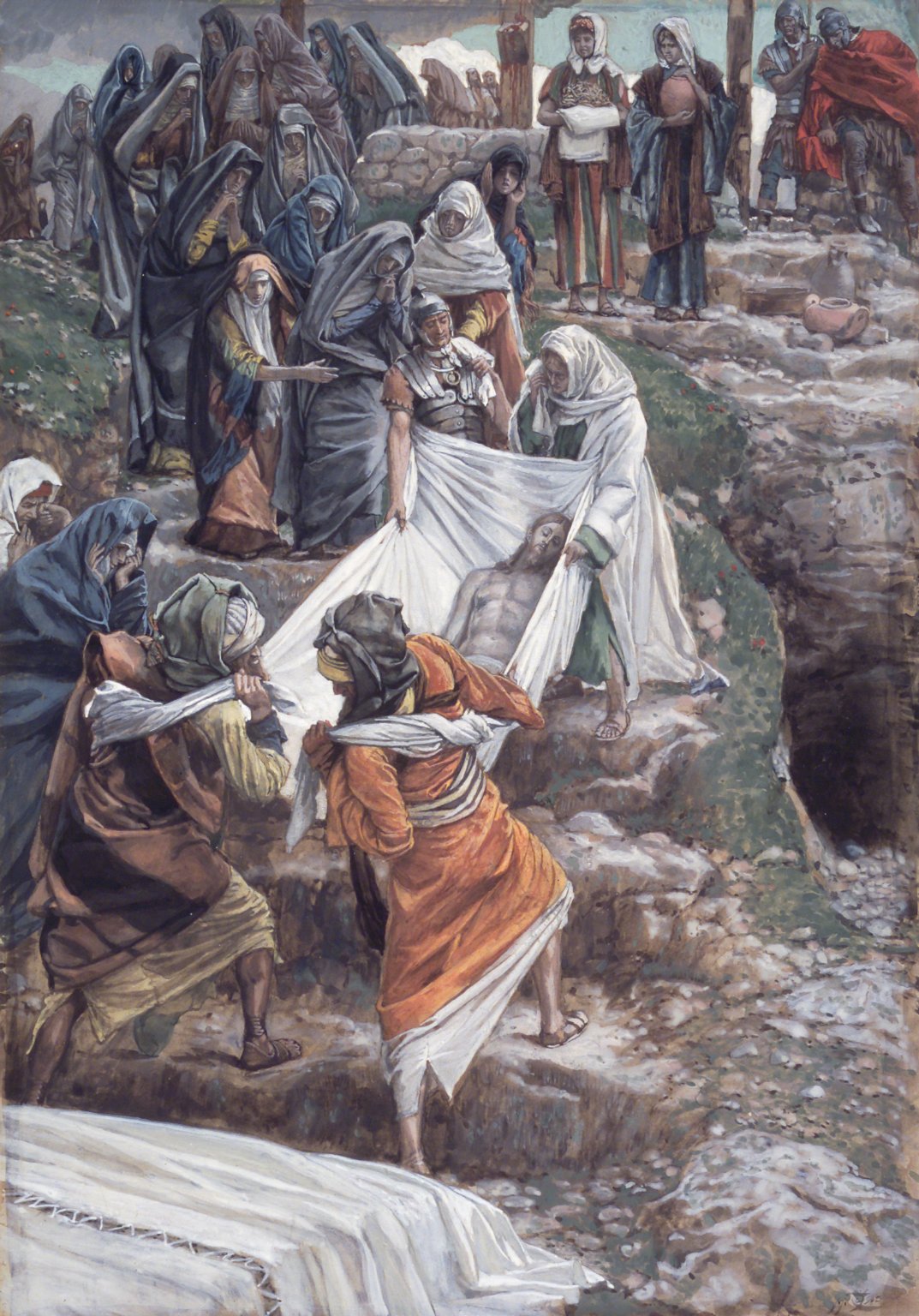
James Tissot (French, 1836-1902). The Body of Jesus Carried to the Anointing Stone, 1886-1894. Brooklyn Museum, Purchased by public subscription, 00.159.322
Luke corroborates this further in his account of Joseph of Arimathea—a God fearing man who asked Pilot for the body of Jesus after the crucifixion. The account documents Jesus was crucified and entombed on the Preparation Day before sundown, before the Sabbath.
Luke 23:52 Going to Pilate, he asked for Jesus’ body. 53 Then he took it down, wrapped it in linen cloth and placed it in a tomb cut in the rock, one in which no one had yet been laid. 54 It was Preparation Day, and the Sabbath was about to begin. (emphasis mine)
Sabbath literally means seven, as it is the seventh day of the week (Saturday). It was a day of rest where no work could be done (Gen. 2:2-3, Ex. 20:9-11). The sixth day (Friday), therefore, was the day of preparation for the Sabbath. Both Luke and Mark (Mark 15:42-44) tell us Jesus died and was buried on the Preparation Day. There is no question Jesus died on Friday afternoon before sundown and was raised to life on Sunday morning, sometime after dawn.
Add to this the unanimous testimony of the Early Church and there is no other conclusion. Below is the Friday crucifixion timeline according to the common understanding of days starting at dawn.
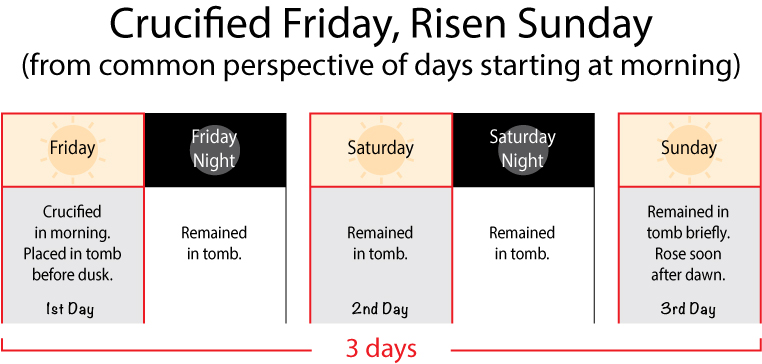
This next chart is in accordance with the Jewish understanding of days starting at dusk. This is how the Disciples would have understood the Resurrection timeline.
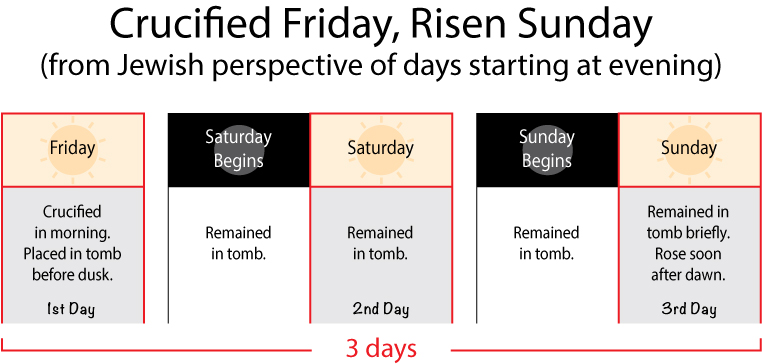
Defining Days
Day can be understood in different ways, depending on context, but the God gave its primary meaning. It is the light portion (daytime) of the day/night cycle.
Gen. 1:3 And God said, “Let there be light,” and there was light. 4 God saw that the light was good, and he separated the light from the darkness. 5 God called the light “day,”and the darkness he called “night.” And there was evening, and there was morning—the first day. (emphasis mine)
In the charts above, you’ll notice all three days are represented.
3 Nights?
But what about the nights? Virtually all references to the Resurrection timeline in the New Testament mention days alone, but one breaks the pattern. In Matthew’s Gospel, Jesus clearly told the Pharisees he would be in the heart of the earth for 3 days and also for 3 nights (Matt. 12:40). And herein lies the problem. If you count a portion of a day as a day, and a portion of a night as a night, you only have two nights from Friday evening to Sunday morning. It’s close, but we’re missing a night portion.
Idiomatic Language
Many try to explain this apparent discrepancy by citing idiomatic language and the principle of inclusive reckoning. The Jews, at that time, viewed any portion of a day as a full day and night. Therefore, 3 days and 3 nights is just an idiomatic way of saying three partial days. Per Meyer’s NT Commentary,
Jesus was dead only a day and two nights. But, in accordance with the popular method of computation (1 Samuel 30:12 f.; Matthew 27:63), the parts of the first and third day are counted as whole days, as would be further suggested by the parallel that is drawn between the fate of the antitype and that of Jonah.
Per Jamieson-Fausset-Brown Bible Commentary,
The period during which He was to lie in the grave is here expressed in round numbers, according to the Jewish way of speaking, which was to regard any part of a day, however small, included within a period of days, as a full day.
I’ve always had misgivings about this explanation. I agree with the principle of inclusive reckoning—that a partial day should be counted as a day—but Christ went further and mentioned nights. What is more, Jesus our Creator, back in Genesis, gave distinct meanings to days and nights (Gen. 1:5). He also assigned a specific number to the days and the nights, each having its own number.
Think of the arguments scientific creationists have made over the decades defending the literal days of creation. Sarfati, for instance, points out that there are 410 instances in Scripture, outside of Genesis 1, when the word day (or days) occurs with a number. In every one of these, it is referring to a normal day.1 Am I off base to wonder if the same argument should apply to nights? Words matter and if Jesus went to the trouble of assigning a specific number to a specific word, we need to take heed, even if it poses some difficulties.
Wednesday to the Rescue?
Many attempt to resolve this difficulty by embracing a Wednesday crucifixion. This is an interesting and elaborate theory many good men have labored over.
Proponents maintain Jesus was crucified Wednesday and buried shortly before sundown. This was, in theory, the day before a special sabbath holiday (the Passover) which happened to fall on Thursday at that time. Wednesday, therefore, became a special day of preparation for this Passover that would begin at sundown that evening.
Wednesday Crucifixion Timeline
The timeline is as follows: Jesus was crucified Wednesday morning, and died before sundown. He was also placed in his tomb before sundown. He remained there all night Wednesday night, Thursday and Thursday night, Friday, and Friday night, and all day Saturday until sundown. Then, at some point after sundown on Saturday night (beginning of Sunday to the Jews), he rose from the dead. The chart below is from the common view of days beginning at dawn.
Here is a chart from the Jewish perspective of the days beginning at dusk.
According to this timeline, Jesus remained 3 full days and 3 full nights in his tomb. He was also in his tomb a small portion of the day on Wednesday and a portion of Saturday night (the start of Sunday), but the important part is, he was 3 full days and nights in the tomb—72 hours.
Saturday Night Resurrection
They, also, maintain Jesus did not rise Sunday morning, but, rather, the night before. To support this, they cite Mary Magdalene’s discovery the empty tomb “while it was still dark.”
John 20:1 Early on the first day of the week, while it was still dark, Mary Magdalene went to the tomb and saw that the stone had been removed from the entrance. (emphasis mine)
Problems with Wednesday
Several things have moved me away from this view, the biggest being Luke chapter 24. Cleopas stated explicitly that Sunday was the third day since the crucifixion and that it had not yet fully passed. They were still in it while they were speaking. The Wednesday theory implies it did pass, and that the next day had started. See the charts below.

 According to the Wednesday theory, Saturday is the third day in the grave. But this can’t be. Look at renderings of this passage by Young and Mounce.
According to the Wednesday theory, Saturday is the third day in the grave. But this can’t be. Look at renderings of this passage by Young and Mounce.
Luke 24:21 ….this third day is passing to-day, since these things happened. (Young’s)
Luke 24:21 ….Indeed besides all this, but it is now the third day since these things happened. (Mounce)
The clear testimony of Scripture is that Sunday was the third day, and was still in progress when Cleopas mentioned it. This confirms Saturday was the second day, and Friday was the crucifixion day.
Heart of the Earth: A closer Look
Then what did Jesus mean by 3 days and 3 nights? A closer look at his statement may be warranted.
Matt. 12:40 For as Jonah was three days and three nights in the belly of a huge fish, so the Son of Man will be three days and three nights in the heart of the earth. (emphasis mine)
Maybe we should focus less on the 3 days and 3 nights, and more on the phrase that followed? What did he mean by “heart of the earth.”
The Grave?
Is it, specifically, a reference to the grave? Most assume it is. I always did. It’s definitely a reference, in part, to Christ’s burial, but is it exclusively a metaphor for the tomb? Upon closer examination, I think not.
First, the heart of the earth metaphor is not found anywhere else in Scripture. It is not used in the Old Testament, nor anywhere else in the New Testament. This is significant because Christ could have used some well known terms and idioms to specify the grave, including the phrase under the earth (Ex. 20:4, Phil. 2:10, Rev. 5:3, Rev. 5:13). He didn’t.
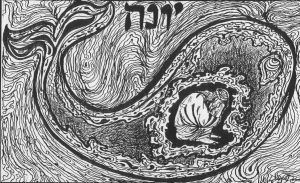 Second, while we don’t have a comparative reference for this specific phrase, we do have a parallel statement. Jesus directly compared himself being in the heart of the earth to Jonah being in the belly of the whale. Thus, heart of the earth and belly of the whale are, in some sense, analogous.
Second, while we don’t have a comparative reference for this specific phrase, we do have a parallel statement. Jesus directly compared himself being in the heart of the earth to Jonah being in the belly of the whale. Thus, heart of the earth and belly of the whale are, in some sense, analogous.
This should not be glossed over. Christ’s experience in the heart of the earth is akin to Jonah’s experience in the belly of the whale, and, interestingly enough, Jonah never died. He was captive, or imprisoned, so to speak, in the belly of the whale, but Scripture does not specifically say he died. Certainly Jesus died, and was speaking of his own death and burial to some extent, but captivity seems to be the general idea in this analogy.
It’s also noteworthy that belly of the whale or belly of the beast are common metaphors, today, and neither imply the grave.
Per Collins Dictionary: Generally it means being in the middle of a very bad situation or a dangerous place. You can be in the “Belly of the Beast” if you go into the central command of enemy headquarters.
This doesn’t necessarily give us insight into the ancient understanding, but it is noteworthy that no one today infers death or the grave from these phrases. They rather imply a dangerous place or situation.
Third, if heart of the earth was to be understood as middle of the earth, it likely would not have registered in the ancient mind as a reference to burial. Earth means land in Scripture. “And God called the dry land Earth” (Gen. 1:10). If this was a literal reference to land, they, more likely, would have understood it as a geographical surface location—middle of the Garden (Gen. 2:9), the middle of the camps (Num. 2:17), the middle of all Israel (Deut. 11:6), etc. It would have been similar to the way we understand the term heartland. For something buried, we’d use a term like underground, which would be akin to the ancient expression, under the earth (i.e. under the land).
Forth, and perhaps most importantly, both heart and earth are common metaphors in Scripture with a range of metaphorical meanings that don’t imply death. Earth, as a metaphor, often refers to the inhabitants of the earth (1Chr. 16:31, Psa. 96:11, Psa. 97:1, Psa. 99:1, Is. 34:1, Is. 45:8). It also depicts sin in various ways—earthly men (1Cor. 15:48), earthly things (Phil. 3:19, Col. 3:2), earthly nature (Col. 3:5), earthly wisdom (James 3:15).
Heart, on the other hand, can refer to the middle of something, but it’s rare. It overwhelmingly conveys the idea of desires and moral values. “He said to them, “You are the ones who justify yourselves in the eyes of others, but God knows your hearts. What people value highly is detestable in God’s sight.”—Luke 16:15.
Hell, Hades, Sheol?
Another popular theory is that heart of the earth refers the underworld where Jesus preached to the captive spirits (1 Peter 3:19–20). The problem is, this realm is never referred to as the heart of the earth.
That said, I can see why some draw this conclusion. To the modern mind, earth is understood as a planet, and its heart as its core. It would be a nomenclature fallacy, however, to impose this thinking on the ancient mind. This is because the modern definition of earth is not perfectly synonymous with the ancient definition. Earth, in the Bible, simply means land. Look how it is defined in Genesis.
Gen. 1:10 And God called the dry land Earth, and the gathering together of the waters He called Seas….
This is further supported by the fact that earth and sea are always distinct in Scripture. Notice how Moses treats them distinctly in his summary of the creation account.
Ex. 20:11 For in six days the LORD made the heavens and the earth, the sea, and all that is in them
Moses, like all the biblical authors, understood the earth and the sea as distinct (Neh. 9:6, Psa. 69:34, Psa. 96:11, Psa. 135:6, Psa. 146:6, Ezek. 38:20, Amos 9:6, Acts 4:24, Acts 14:15, Rev. 10:6, Rev. 12:12, Rev. 14:7, Rev. 21:1). That’s because the general meaning of earth in the Bible is land.
The phrase heart of the earth, therefore, should literally be understood as heart of the land, and likely does not mean what most have assumed.
Earthly Rulers and Judges
This brings me to my thesis, that heart of the earth is a reference to earthly rulers and judges. A clue for this theory might be found in the Book of Deuteronomy where Moses reminded the Israelites what God did to the ruling authorities in Egypt. Notice the metaphor.
Deut. 11:3 the signs he performed and the things he did in the heart of Egypt, both to Pharaoh king of Egypt and to his whole country; 4 what he did to the Egyptian army, to its horses and chariots, how he overwhelmed them with the waters of the Red Sea as they were pursuing you, and how the LORD brought lasting ruin on them.
Moses is speaking of the middle of a specific land—the land of Egypt. Notice, also, he identifies the rulers of this land (Pharaoh and his armies) as the heart. Pharaoh’s heart, which was hardened by God, was also the heart of Egypt which was ultimately judged by God. As mentioned above, the heart is akin to the values of an individual or people. The will of a nation is controlled by its heart—it’s governing authorities.
The Incarceration of Jesus
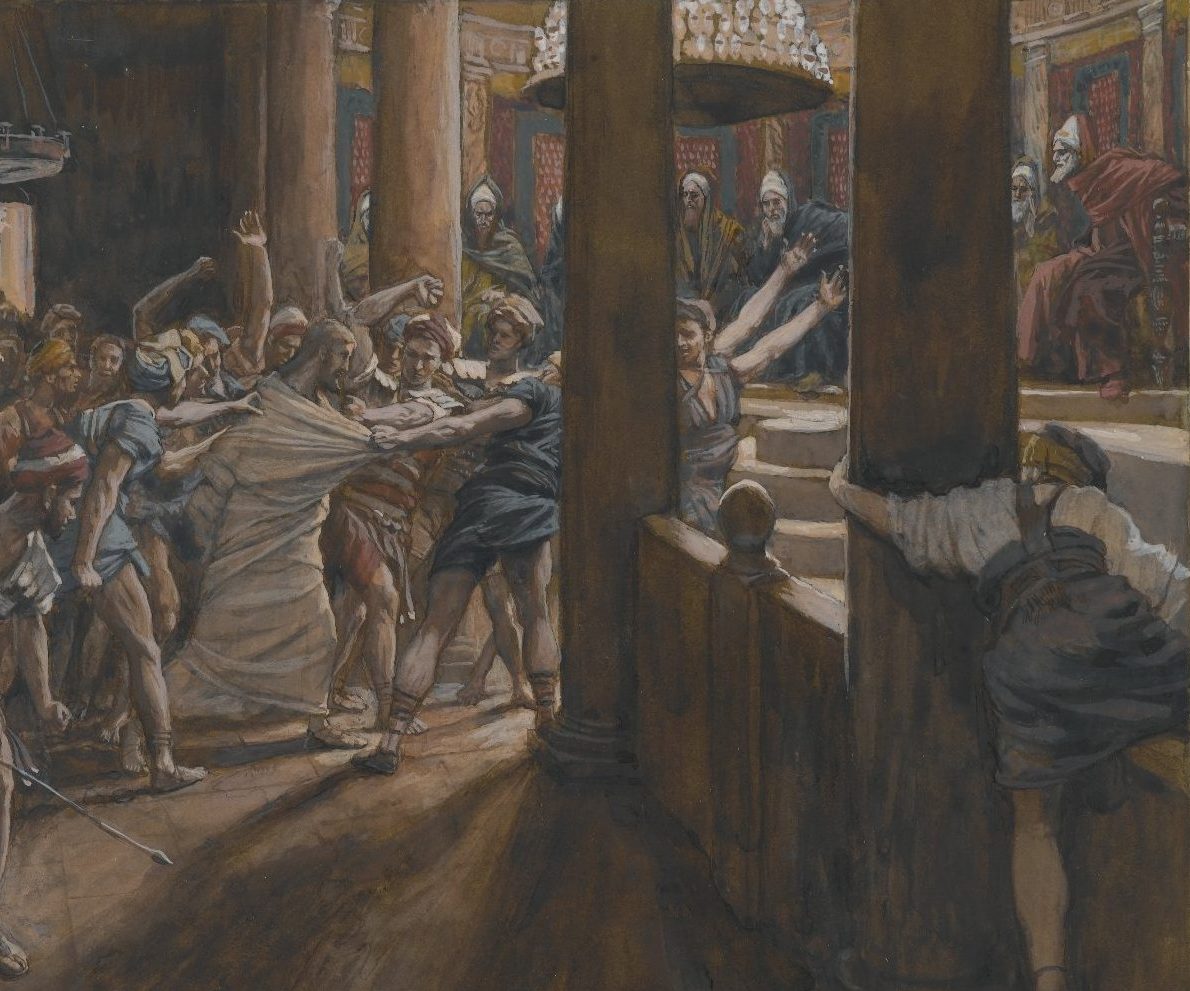
James Tissot (French, 1836-1902). The Tribunal of Annas, 1886-1894. Brooklyn Museum, Purchased by public subscription, 00.159.243
With this in mind, I would propose Jesus was not speaking of his death and burial alone, when he spoke about the heart of the earth. It was included, but he was speaking more broadly of his subjection to earthly authorities.
Jesus was crucified Friday morning, but arrested and taken captive the night before in Gethsemane. This is when the horror of the Passion began. This is when he entered the belly of the whale, so to speak.
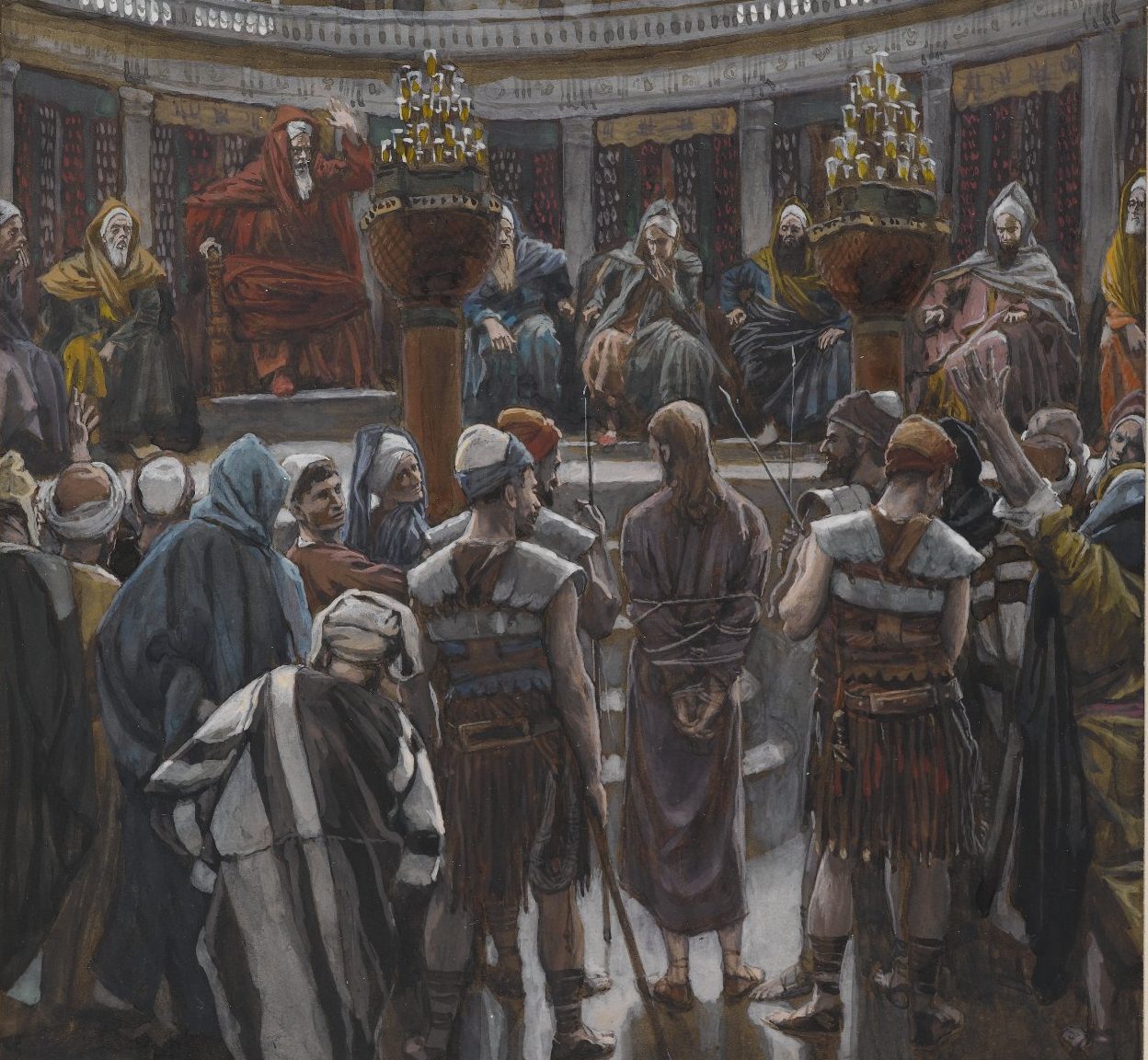
James Tissot (French, 1836-1902). The Morning Judgment, 1886-1894. Brooklyn Museum, Purchased by public subscription, 00.159.254.
Jesus died for us, but was also made sin for us (2Cor. 5:21). I suggest this began Thursday night, the moment he allowed himself to be captured and judged by earthly (sinful) men. The rulers and Pharisees attempted to incarcerate him many times, but Jesus did not permit it until that fateful Thursday night. That’s when he willingly gave himself over for judgement. That’s when he entered the heart of the earth (incarceration, judgement, crucifixion, death, burial) where he remained until his resurrection on Sunday morning.
I believe this conveys the true meaning of the heart of the earth, and if I’m correct, we’ve found our missing night! Below is the heart of the earth timeline according to the modern understanding of days.
This timeline is even more comprehensive when looked at from the Jewish perspective of days.
Corroborating References
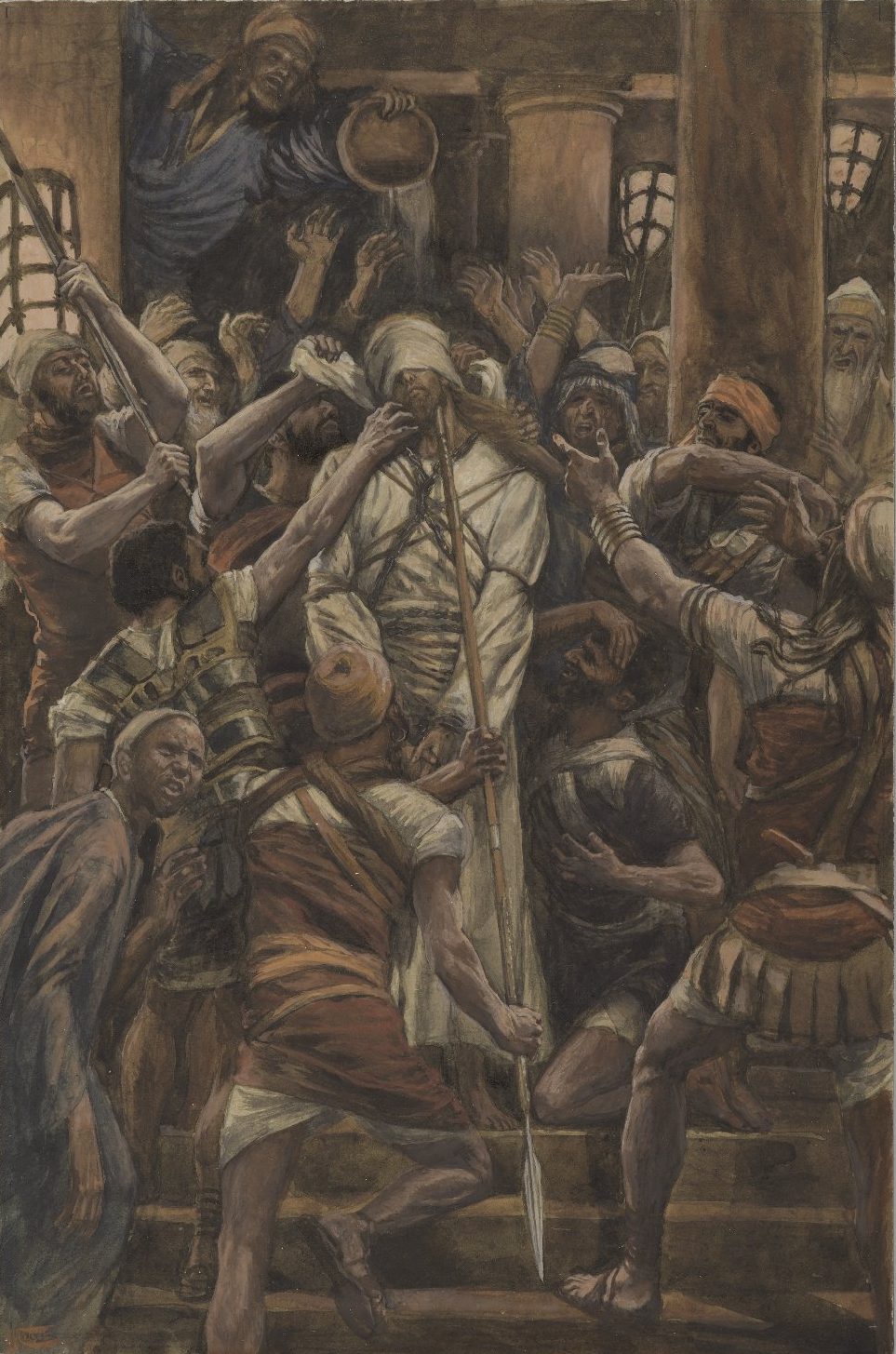
James Tissot (French, 1836-1902). Maltreatments in the House of Caiaphas, 1886-1894. Brooklyn Museum, Purchased by public subscription, 00.159.252
Does the rest of the New Testament corroborate this focus on the arrest and incarceration of Jesus? Indeed it does. Let’s go back to Luke 24 and look closely at the testimony of Cleopas.
Luke 24:20 The chief priests and our rulers handed him over to be sentenced to death, and they crucified him; 21…. And what is more, it is the third day since all this took place. (emphasis mine)
Notice he didn’t just cite the crucifixion, but also mentioned the handing over of Jesus to earthly authorities. This is a focus we find throughout all the Gospels. All of the passages below reference Christ’s incarceration in conjunction with his crucifixion and resurrection on the third day.
- “suffer many things at the hands of the elders, the chief priests and the teachers of the law,“ crucified, resurrected third day (Matt. 16:21)
- “delivered into the hands of men,” crucified, resurrected third day (Matt. 17:22)
- “delivered over to the chief priests and the teachers of the law,” crucified, resurrected third day (Matt. 20:18-19, Mark 10:33-34)
- “suffer many things and be rejected by the elders, the chief priests and the teachers of the law,” crucified, resurrected third day (Luke 9:21-22)
- “delivered over to the Gentiles,” crucified, resurrected third day (Luke 18:32-33)
- “delivered over to the hands of sinners,” crucified, resurrected third day (Luke 24:7).
The delivering over of Jesus to earthly authorities is rarely left out of the resurrection timeline. It’s difficult to find a third day reference that doesn’t include it.
Jonah a Type of Christ
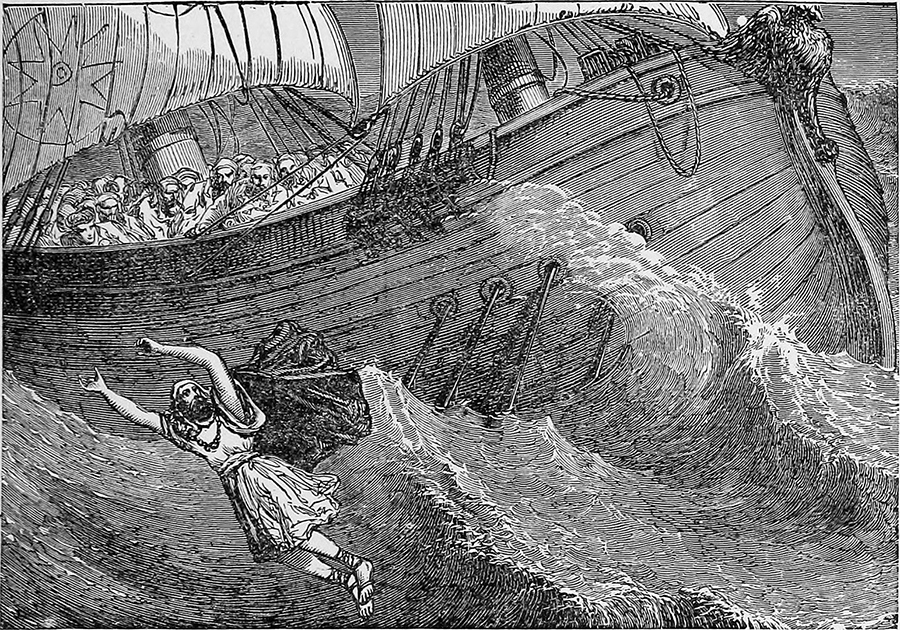 It’s also notable that, if the incarnation is included in the heart of the earth timeline, Jonah becomes an almost perfect messianic type. For, Jonah entered the sea and the custody of the whale, willingly, much like Jesus entered into the custody of sinful men. Note Jonah’s final words on the ship.
It’s also notable that, if the incarnation is included in the heart of the earth timeline, Jonah becomes an almost perfect messianic type. For, Jonah entered the sea and the custody of the whale, willingly, much like Jesus entered into the custody of sinful men. Note Jonah’s final words on the ship.
Jonah 1:12 “Pick me up and throw me into the sea,” he replied, “and it will become calm. I know that it is my fault that this great storm has come upon you.”
Though Jonah ran from God’s command initially, he willingly became captive to the whale for the sake of the others. He did not fight for his life, but offered it, on his own accord, for his shipmates. In that sense, he became a clear type of his Messiah who was to come.
John 10:17 The reason my Father loves me is that I lay down my life—only to take it up again. 18 No one takes it from me, but I lay it down of my own accord. I have authority to lay it down and authority to take it up again. This command I received from my Father.”
This was the sign of Jonah (Matt. 12:39, Matt. 16:4, Luke 11:29-30).
Just one loose end remaining. Did Jesus rise Saturday night or Sunday morning?
Definitely Sunday Morning
What about Mary Magdalene’s testimony that it was still dark when she discovered the empty tomb?
John 20:1 Early on the first day of the week, while it was still dark, Mary Magdalene went to the tomb and saw that the stone had been removed from the entrance. (emphasis mine)
Sunrise is not characterized by darkness. Once the sun cracks the horizon, the day is bright and all darkness is gone. Does this mean Jesus rose at night, before morning? If it does, our timeline is, once again, in jeopardy.
The objection, however, comes from a misunderstanding about when morning starts.
Defining Morning
Evening and morning are transitional periods that mark the close of the day and the close of the night. Take a look at how God defines them.
Gen. 1:5 God called the light “day,” and the darkness he called “night.” And there was evening, and there was morning—the first day.
Notice that evening (‘erev) is paralleled with day, while morning (boqer) is paralleled with night. This is because evening marks the close of the day, while morning marks the close of the night: Day > evening > Night > morning.
The day ends at dusk (evening), when the light begins to fade to darkness. Conversely, the night ends at dawn (morning), when the darkness begins to give way to light—a process that begins 30-45 minutes prior to sunrise. This is true in modern thinking as well. (Here are a couple of interesting articles on dusk and dawn that might be helpful. What Is Dusk? and What Is Dawn?)
Early
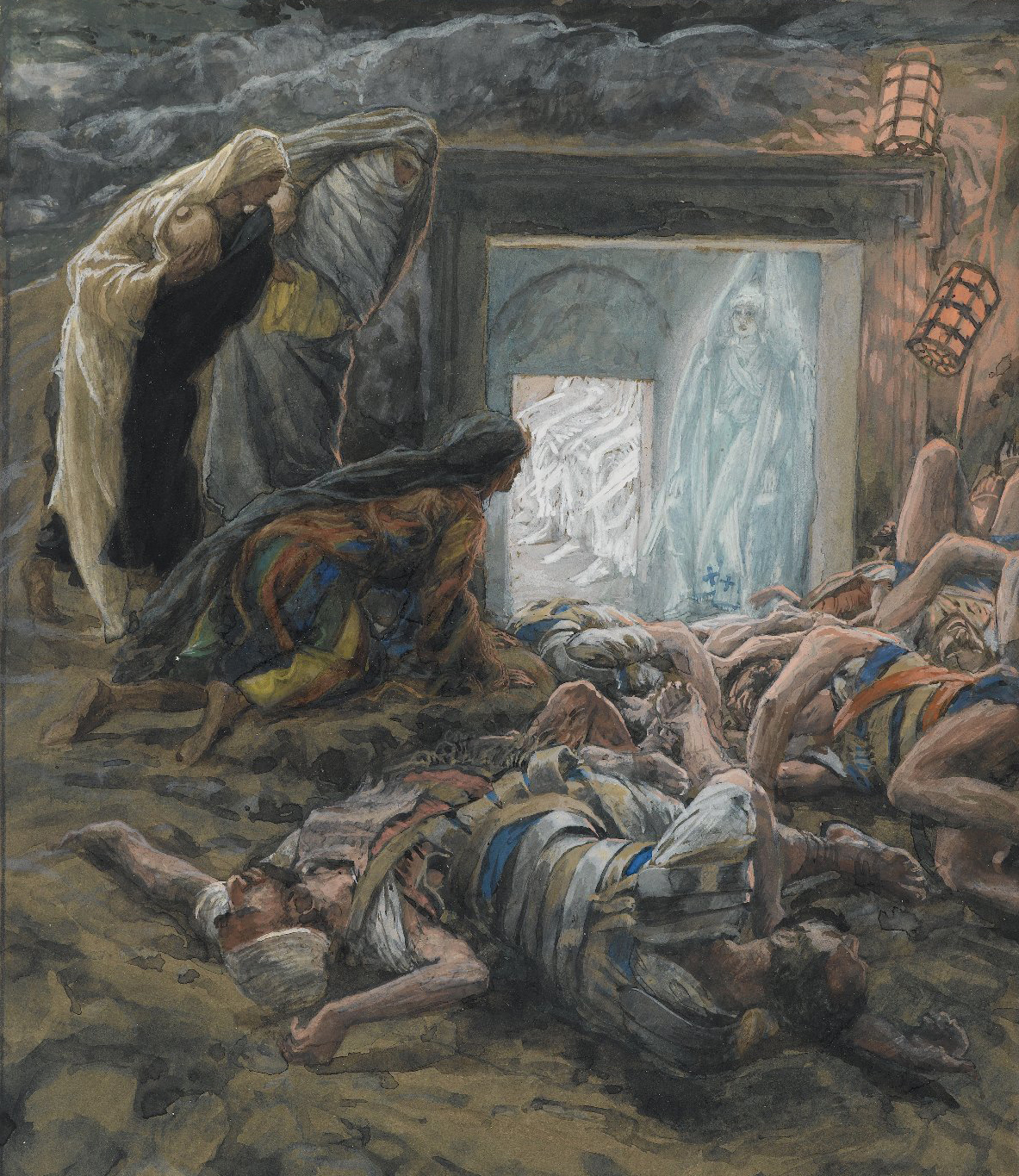
James Tissot (French, 1836-1902). Mary Magdalene and the Holy Women at the Tomb, 1886-1894. Brooklyn Museum, Purchased by public subscription, 00.159.329
If you’re still not convinced, we need only to examine the term early (proi in the Greek), from John’s account of Mary Magdalene. It literally means in the morning, early (Mounce Greek Dictionary).
John 20:1 Early on the first day of the week, while it was still dark, Mary Magdalene went to the tomb and saw that the stone had been removed from the entrance. (emphasis mine)
Clearly John was speaking of the persisting darkness of the twilight of the morning, before sunrise. It would make no sense for him to use this term, had Mary Magdalene visited the tomb at night, before dawn.
Some may still persist and point out that John’s passage does not explicitly mention the resurrection, only the discovery of the empty tomb. But Mark’s parallel passage does.
Mark 16:9 Now when He rose early on the first day of the week, He appeared first to Mary Magdalene, out of whom He had cast seven demons. (emphasis mine)
Case closed! Jesus was taken into custody for judgement Thursday night, tried and crucified on Friday and then rose again early in the twilight of the morning on Sunday. Our 3 day and night timeline is complete.
Does it matter?
Good men disagree on this topic. The truth is, I may be wrong. I may have missed something big, and if so, I trust others will reach out and let me know.
I would, however, challenge readers to consider the importance of interpreting the Bible in a straightforward fashion. Passages should be taken literally unless there are clear indications to do otherwise. Christ’s specific mention of 3 nights is explicit and deserves serious consideration. I hope I’ve provided that above.
Furthermore, skeptics cite this apparent timeline discrepancy as an “error” in Scripture (see: notes from the Skeptic’s Annotated Bible). Do we have a good answer for them? We should.
1Pet. 3:15 But sanctify the Lord God in your hearts, and always be ready to give a defense to everyone who asks you a reason for the hope that is in you, with meekness and fear;
Final Thought
For me, the real blessing of this study was not merely solving the riddle of the Resurrection timeline and the meaning of the phrase heart of the earth (if I’ve indeed discovered it).
That was a blessing to be sure, but the bigger blessing was a deeper understanding Jesus’ sacrifice. The picture is now bigger and more vivid. It began Thursday night in Gethsemane where he willingly entered into the hands of sinful rulers. He endured their judgements through the night and into the morning. Then he endured the Cross all day, and died to atone for the sins of the world. Afterward, he was placed in his tomb, where he remained until Sunday morning, when he rose and raised me up with him.
Col. 3:1 If then you were raised with Christ, seek those things which are above, where Christ is, sitting at the right hand of God.
Thank you, Lord.



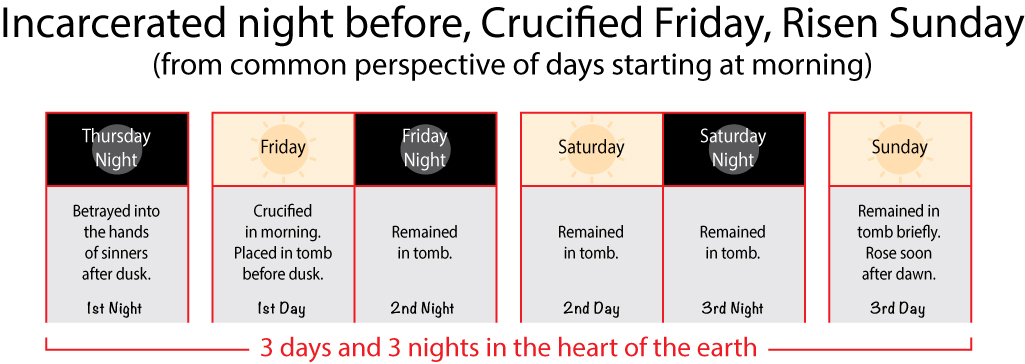
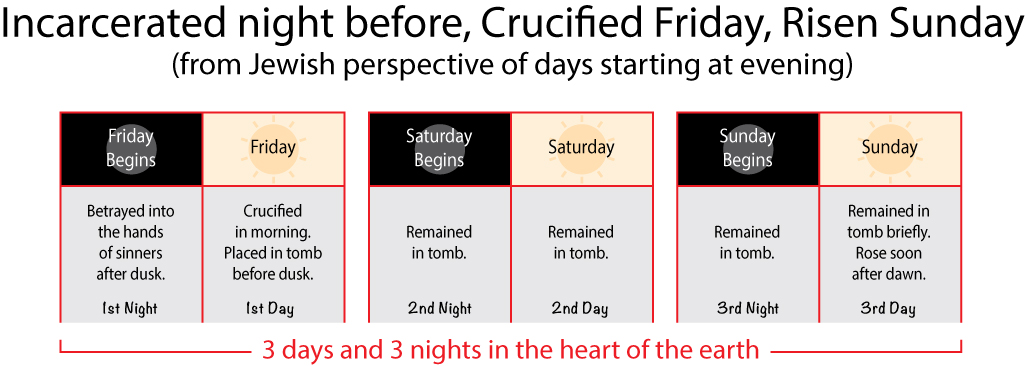
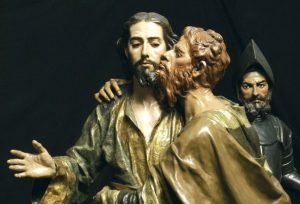
Leave a Comment
You must be logged in to post a comment.